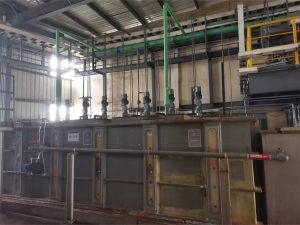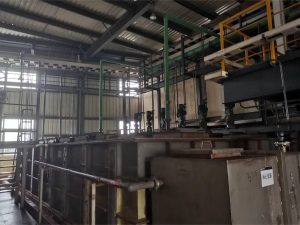Optimizing lithium battery recycling involves four key steps: Pre-treatment, chemical leaching, solid-liquid separation, and resource recovery, achieving up to 95% efficiency in material reclamation.
Pre treatment Processes
Collecting and Pre-Sorting
The pre-treatment process starts by collecting used lithium batteries from a range of sources including electronics manufacturers, service centers, and recycling bins. Specific sorting methods are used to separate lithium batteries according to their type, state and possible contamination. In this phase, AI and image recognition are a key element, with automated sorting systems being able to identify and categorize battery types with up to 95% accuracy.
Disassembly
After being sorted, batteries are disassembled to save valuable engineering resources like cathodes, anodes, and electrolytes. This step is very technical and uses robotic arms and custom tools to work with the sensitive and sometimes dangerous materials without spoiling them or causing them to become contaminated. This breaks a battery down to about 80 percent of its original components that can go back into the recycling loop.
Safety Measures
Lithium batteries are very dangerous, so safety is the number 1 concern. The pre-treatment includes several precautions in order to avoid overheating and combustion. All plants include state-of-the-art fire suppression systems and are configured to safely contain any unforeseen occurrences. This preventative measure not only shields individuals but also reduces the ecological influence of the recycling treatment.
Preparation for Further Processing
The last stage of pre-treatment is the grinding of the extracted materials for subsequent processing. Cleaning and conditioning materials–usually, with chemical or mechanical methods–so that they are in the best possible shape for the rest of the recycling process This phase is crucial because it may well be a limiting step in the effectiveness and efficiency of subsequent chemical leaching or other recovery mechanisms.
Chemical Leaching
Introduction of Leachants
The leaching chemicals (acids like sulfuric or hydrochloric acid) are added to help dissolve the good metals in the processed battery components, which is a critical stage. Leachant chosen should depend which metal recovery is targeted (i.e. sulfuric acid is frequently employed to leach lithium out, while hydrochloric acid may be preferred for working on other elements). Leachant concentration and temperature are monitored closely in order to maximize recovery and reduce waste.
Tuning Reaction Parameters
The success of leaching operation depends on the maintenance of ideal environment for reactions. And this requires fine control of the process conditions, such as maintaining a temperature range of 50 to 90 degrees Celsius, at the same time as adjusting the pH to enable good metal dissolution while preventing the destruction of other valuable elements. The rate of mixing and mixing time are adjusted to achieve large contact between the leachant and the material, and to obtain recoveries more than of 90%.
Separation of Solids and Liquids
Following the leaching reaction, the slurry is left with a combination of metallic compounds that are no longer solid and undissolved waste. A key operation is the solid liquid separation, normally done by filtration or by centrifugation. This step has the additional benefit of also separating out the waste residues, which are treated independently to meet environmental regulations.
Metal Recovery
The leaching process extracts a metal-rich solution which is purified and recovered. Methods such as precipitation, solvent extraction, and ion exchange can recover specific metals at largely higher purities. For example, lithium can be precipitated as lithium carbonate (a high-value form for battery manufacturers) using sodium carbonate as a precipitant.

Solid Liquid Separation
Filtration Techniques
Filtration is used in the solid-liquid separation stage to remove the particulate matter from the leachate. Various filters, including vacuum filters or pressure filters, are employed to successfully separate the solids and liquids. Filter presses in advanced recycling operations have separation efficiencies in excess of 95%, ensuring the greatest percentage of liquid extractant is recovered for further metal recovery processes.
Centrifugation
Firstly centrifugation is another effective process for solid-liquid separation where the slurry is rotated at high speed so as to separate the solid waste portion of liquid metal solution based on their density. Centrifuges work well with fine particles that are hard to be captured using filter. The can increase the reclaimed leachate yield by reclaiming which means valuable metals will not be within the solid waste.
Clearing Up & Cleaning Out
After the first separation, you clarify the liquid to get rid of the last remaining very fine particles. This may require some sort of further light filtering or chemical treatment to clear the solution up. The cleaner the Leachate is, the better Metal Recovery is going to be. This is crucial to achieve as it determines the impurities of the leachate, and hence the quality and efficiency of the metal recovery stage.
Waste Management
The remnants of the separation are managed under strict environmental guidelines to ensure hazardous materials are never a danger. Stabilization of such waste, in turn stabilizes the waste stream and prepares it for ultimate disposal or better yet, haul it back into other reusable industries. Proper disposal and treatment of this waste are monitored by the regulatory agencies to prevent its harmful consequences on the environment.

Resource Recovery
Metal Precipitation and Extraction
The clarified leachate stream is first treated with metal precipitation or extraction steps to recover the metals. Techniques such as chemical precipitation, solvent extraction, and ion exchange are then used depending on the metals to be recovered. For example, lithium is generally extracted as lithium carbonate or lithium hydroxide materials, which are key ingredients in new battery cells. Collections of these methods usually obtain a recovery percentage of greater than 90 % in regard to the metal that is used.
Refinement and Purification
Metals are mined, and after they are removed from the ground, they are refined still further to meet the industry standards required for use in batteries. Typically this will mean further purification via something like electrolysis, where metals can be purified to 99.5% purity levels or greater. This is a very important stage so that metals recovered later are able to comply with the tough quality standards battery manufacturers demanded.
Reintegration into Battery Production
Those recovered materials are then reused in the process of manufacturing new batteries. This is a fundamental part of the circular economy, as less material has to pass all the way, from the extraction of raw materials to the disposal at end of life. New battery content can be 30-40% recycled, substantially lowering the carbon footprint from battery manufacturing.
Innovations in Resource Recovery
Recent technological developments provide for increasingly effective resource recovery. This includes innovations like automated sorting and AI-driven analysis that assist in maximizing the amount of material recovered and reducing the cost to operate. These are advances that will be critical in advancing recycling technology to scale against higher numbers of spent lithium batteries.
